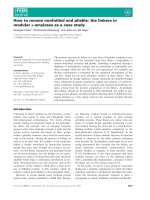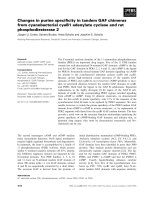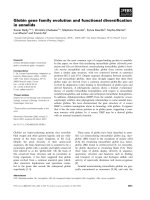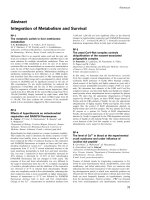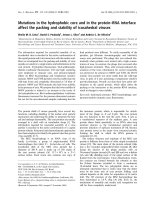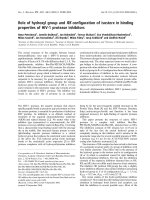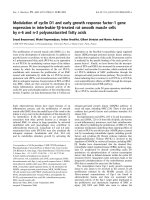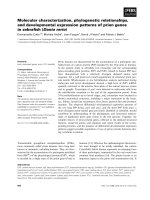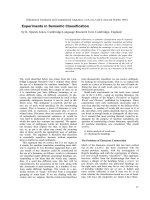Báo cáo khoa học: " Pronominalization in Generated Discourse and Dialogue" pdf
Bạn đang xem bản rút gọn của tài liệu. Xem và tải ngay bản đầy đủ của tài liệu tại đây (81.22 KB, 8 trang )
Pronominalization in Generated Discourse and Dialogue
Charles B. Callaway
Istituto per la Ricerca Scientifica e
Tecnologica (ITC-irst), Italy
James C. Lester
Department of Computer Science
North Carolina State University, USA
Abstract
Previous approaches to pronominalization
have largely been theoretical rather than
applied in nature. Frequently, such meth-
ods are based on Centering Theory, which
deals with the resolution of anaphoric pro-
nouns. But it is not clear that complex the-
oretical mechanisms, while having satis-
fying explanatory power, are necessary for
the actual generation of pronouns. We first
illustrate examples of pronouns from vari-
ous domains, describe a simple method for
generating pronouns in an implemented
multi-page generation system, and present
an evaluation of its performance.
1 Introduction
Pronominalization is an important element in the au-
tomatic creation of multi-paragraph and multi-page
texts using natural language generation (NLG). Au-
thors routinely use pronouns in texts spanning all
types of genres, such as newspaper copy, science
fiction and even academic papers. Indeed, without
pronouns, texts quickly become confusing as readers
begin to pay more attention to the writing style than
to the content that makes the text informative or en-
joyable (Callaway and Lester, 2001a). Even worse,
incorrect pronouns can lead readers to misinterpret
the text or draw unsound inferences.
Furthermore, current pronominalization strategies
are ill-equipped to deal with the wide variety of
reasons that pronouns are used in naturally occur-
ring texts. Almost without exception, they focus on
anaphoric pronouns as described in Focus/Centering
Theory (Webber, 1979; Sidner, 1983; Grosz and Sid-
ner, 1986; Walker, 1998), ignoring the multitude of
other possible types. However, it is certainly true
that authors make use of pronouns which are not mo-
tivated by anaphoric reference.
In addition, because such approaches are oriented
towards anaphora resolution during parsing, they ig-
nore structures such as the discourse plan which are
present during generation but not parsing. A typi-
cal discourse plan can include vital information for
pronominalization such as time and clause bound-
aries, ordering of propositions, and semantic de-
tails verbal arguments. Current approaches based
on Centering algorithms thus attempt to recreate a
text coherence structure that duplicates work already
done by the discourse planner.
Finally, there are significant obstacles to verifying
the correctness of existing pronominalization algo-
rithms for any pronominalization theory (Not, 1996;
Yeh and Mellish, 1997; McCoy and Strube, 1999;
Henschel et al., 2000; Kibble and Power, 2000): the
lack of natural language generation systems that can
produce large enough texts to bring discourse-level
processes into play. Because of this, researchers are
forced to simulate by hand how their algorithms will
work on a given text. It is also not sufficient to use
template generation systems to perform this task be-
cause they lack the low-level discourse representa-
tion needed to provide the information upon which
most algorithms base their decisions.
In this paper we first summarize related work
in both anaphora resolution and anaphora genera-
tion. We next describe the range of pronoun types
Computational Linguistics (ACL), Philadelphia, July 2002, pp. 88-95.
Proceedings of the 40th Annual Meeting of the Association for
that we found in a wide variety of texts. We pro-
ceed to describe an algorithm for determining ap-
propriate pronominalizations that uses existing NLG
structures and simple numeric techniques. We also
briefly describe an implemented generation system
that contains enough low-level discourse informa-
tion to motivate pronominalization decisions using
this method. Finally, we quantitatively demonstrate
the performance of this simple numerical approach
in both a newspaper and fictional narrative domain.
2 Background and Related Work
Because most NLG systems have focused on lin-
guistic phenomena at the paragraph level and be-
low, there has been intensive investigation into the
core areas of generation that are required to pro-
duce them: discourse planning, sentence planning
and surface realization. Since pronouns are more
likely to be a multiparagraph, discourse-level phe-
nomenon, it has been possible to ignore their inclu-
sion into working NLG systems which are not called
upon to generate lengthy passages.
Indeed, most work on pronouns in computational
linguistics has come under the heading of anaphora
resolution as an element of parsing rather than the
heading of pronominalization as an element of gen-
eration. Since discourse anaphora resolution was
first studied theoretically (Grosz, 1977; Webber,
1979; Sidner, 1983; Grosz and Sidner, 1986), it has
come to be dominated by Centering Theory (Grosz
et al., 1995; Di Eugenio, 1998; Walker, 1998) which
proposes rules for the determination of focus and
salience within a given segment of discourse. Rel-
atively little work has been done on alternate ap-
proaches to pronoun resolution (Hobbs, 1976; Bald-
win, 1995).
While many NLG researchers have attempted to
transfer the ideas of Centering Theory to genera-
tion (Not, 1996; Yeh and Mellish, 1997; McCoy
and Strube, 1999; Henschel et al., 2000; Kibble
and Power, 2000), there has yet been no substan-
tial return contribution to the field of anaphora res-
olution. There are two principal reasons for this.
First, it is extremely difficult to create an NLG sys-
tem that generates the large quantity of texts needed
to exhibit discourse-level phenomena while consis-
tently employing the deep linguistic representations
needed to determine appropriate pronominal forms.
Second, Centering Theory is still vague on the ex-
act definition of terms such as “segment” (Poesio et
al., 1999a), making it difficult to create a mutually
agreeable implementation.
An additional area of NLG research that deals
with pronouns is that of referring expression gen-
eration (Appelt, 1985; Heeman and Hirst, 1986;
Claassen, 1992; Dale, 1992), which attempts to find
the optimal noun phrase (whether full description,
definite description, deixis, pronoun, or reduced
noun phrase) to enable a reader to mentally select the
intended referent from the set of possible referents
(Reiter and Dale, 1997). Comparatively, referring
expression generation is a process for local disam-
biguation and is not generally concerned with single
phenomena spanning multiple paragraphs. Because
of this, and because the domains and genres we have
studied typically do not involve sets of very simi-
lar referents, we concentrate on discourse-motivated
sources of pronominalization.
3 Examples of Pronominalization
Pronominalization is the appropriate determination,
marking and grammatical agreement of pronouns
(he, she, their, herself, it, mine, those, each other,
one, etc.) as a short-hand reference to an entity or
event mentioned in the discourse. As with anaphora
resolution, the task of a pronominalization algorithm
is to correctly predict which pronoun a person would
prefer in the same situation. The range of possibili-
ties includes leaving the noun phrase as it is, reduc-
ing it by removing some of its modifiers, or replac-
ing it with a pronoun construction.
Our corpora analyses have identified a number of
motivations for converting nouns into pronouns:
1. Anaphoric pronouns: These are the most-
studied cases of pronoun occurrences, which
sequentially follow a specific entity known as
the referent. Anaphors are divided into two
classes, short-distance (within the same sen-
tence) and long-distance (previous sentences).
But John
had never been to New Orleans,
and he
couldn’t remember if anyone in his
family had either.
2. Cataphoric pronouns: According to Quirk et
al. (1985), cataphors are those pronouns which
occur before their referents in the linear flow of
text within the same sentence, where the pro-
noun is either at a lower structural level or is
part of a fronted circumstantial clause or prepo-
sitional phrase which could have appeared after
the reference. Additionally, this category could
include clefting pronouns.
Before he joined the navy, Gerald made
peace with his family.
3. Pronouns Lacking Textual Antecedents: This
category includes document deixis (via a
demonstrative pronoun), authorial or reader
reference, and situational pronouns.
This is the first document to show .
We discuss these strategies in the next section.
The group had never seen anything like it.
4. Reflexive and Reciprocal Pronouns: Most
verbs use special pronouns when the subject
and object corefer. A discourse history algo-
rithm can employ that knowledge to mark re-
flexive and reciprocal pronouns appropriately.
Kittens
often watch themselves in mirrors.
Baby lions
tackle each other when playing.
5. Partitive pronouns: It is important to know con-
ceptually what it is that the pronoun is trying
to replace. Otherwise, it becomes impossible
to achieve the types of pronominalizations that
authors are routinely capable of creating. This
requires accurate information in the knowledge
base or linguistic structure from which the sen-
tences are derived.
As the horses ran by, she roped one.
* As the horses ran by, she roped it.
* As the horses ran by, she roped them.
In addition to these motivations, we identified
several factors that prevent pronouns from occurring
where they otherwise might:
6. Pronouns across boundaries: After a chapter,
section or other obvious boundary, such as a
change in time, place, or both, as in (McCoy
and Strube, 1999), authors will typically “re-
set” pronominalization just as if it were the
beginning of the entire text. Antecedent ref-
erences that break these boundaries are some-
times marked by the authors in academic texts:
As we saw in the previous section, .
7. Restrictions from modifiers: Because pronouns
cannot have modifiers like nouns, adding an ad-
jective, relative clause, or some other modifier
prevents a noun from being replaced by a pro-
noun. For instance:
The mayor had already read the full proposal.
* The mayor had already read the full it.
8. Focused nouns: Especially after a vocally
stressed discourse marker (Wolters and Byron,
2000) or some other marked shift in topic, a
word that normally would be pronominalized
is often not, as in this example:
and you frequently find that mice occupy
an important part of the modern medical labo-
ratory. In other words, mice are especially nec-
essary for diagnosing human cancers .
9. Semantic and syntactic considerations:A
small number of semantic relations and syntac-
tic constructions prohibit pronominalization:
* The stranger was just called him. (Bob)
* Roberta was no longer a her. (child)
* The father, a tyrant of a him, . (man)
10. Optional pronominalization: Often there are
borderline cases where some authors will use
pronouns while others won’t. A single algo-
rithm may be tuned to match a particular au-
thor’s style, but parameterization will be nec-
essary to match a variety of styles. Thus it is
extremely difficult to exactly match any partic-
ular text without having the ability to adjust the
pronominalization algorithm.
Pronominalization occurs equally as often in ex-
position as in dialogue, but dialogue can have
slightly different pronominalizations depending on
the relationship between the utterer and the hearer:
11. Speaker self-reference:
“John thinks John will go find John’s shoes,”
John said.
changes to first person singular pronouns:
“I think I will go find my shoes,” John said.
12. Speaker references hearer(s):
“Mary should go find Mary’s shoes,” John
said.
changes to second person pronouns:
“You should go find your shoes,” John said.
13. Reference to speaker and hearer (or to speaker
and a third party):
“John and Mary should go find John and
Mary’s shoes,” John said.
changes to first person plural pronouns:
“We should go find our shoes,” John said.
14. Reference to a third party:
“Bob and Mary went to eat Bob and Mary’s
breakfast,” John said.
changes to third person plural pronouns:
“They went to eat their breakfast,” John said.
15. Finally, the treatment of pronouns differs de-
pending if they are inside or outside of the di-
rect quotation. For example:
“Oh man, I forgot to eat my breakfast!” John
muttered to himself while grabbing his shoes.
Although this enumeration is surely incomplete,
it provides a basic description of the types of phe-
nomena that must be handled by a generation system
in order to produce text with the types of pronouns
found in routine human-produced prose.
4 Architectural Concerns
In order to correctly account for these phenomena
during generation, it is necessary to have detailed
information about the underlying discourse struc-
ture. Although a template generation system could
be augmented to record this information, in practice
only deep structure, full-scale NLG systems have the
requisite flexibility. Because a pronominalization al-
gorithm typically follows the discourse planner, it
frequently has access to the full discourse plan.
A typical discourse plan is a tree structure, where
internal nodes represent structuring relations while
leaf nodes represent individual sentential elements
that are organized semantically. In addition, the ele-
ments of the discourse tree are typically rooted in the
semantic knowledge base which the discourse plan-
ner drew from when constructing the discourse plan.
The discourse plan supplies the following informa-
tion that is useful for pronominalization:
Linearization: The sequencing information
stored in the discourse tree can be used to mo-
tivate anaphoric and cataphoric pronouns as
shown in items 1 & 2 of Section 3.
Semantic Structure: The original subgraphs
(or semantic subnetworks) derived from the
knowledge base can motivate content vs. sit-
uational knowledge (item 3) reflexive and re-
ciprocal pronouns via argument lists (item 4),
partitive pronouns (item 5), and the existence
of NP modifiers (item 7), and can identify se-
mantic types in relations (item 9).
Discourse Structure: The rhetorical relations
that hold between different sentences typically
imply where section boundaries are located
(item 6), indicate what types of discourse mark-
ers are employed (item 8), and in the case of
dialogue, know which actors are speaking, lis-
tening, or not present (items 11-15).
This detailed knowledge of the discourse is avail-
able to an implemented pronominalization compo-
nent utilizing any theory, including Centering the-
ory. We thus now turn our attention to what role this
information plays in a pronominalization algorithm.
5 A Simple Pronominalization Algorithm
At an abstract level, the pronominalization algo-
rithms derived from Centering theory are easily ex-
pressed: if Centering theory predicts a pronoun
would be used in anaphora resolution in a given seg-
ment of text, then generate the appropriate pronoun.
While this works for many cases of anaphoric pro-
nouns [84.7% in (McCoy and Strube, 1999), 87-
90% in (Henschel et al., 2000)], we have seen that
these form only a subset of the potential reasons for
pronominalization. Furthermore, this approach as-
sumes that the discourse tree was constructed with
Centering theory in mind.
Given:
, the linearized list of nominal elements
, the current nominal element
, the list of encountered nominal elements
, the dialogue state of the current leaf node
, the rhetorical structure near the leaf node
, the sentence counter
Do:
while do
if
then - ,
else -
if - -
then
else if
( -
if
then -
else if - -
then
else if -
then
else if -
and -
then ,
else if
then ,
-
Figure 1: The Pronominalization Algorithm
However, it is not clear that Centering theory itself
is necessary in generation, let alone its accompany-
ing algorithms and data structures. Because Cen-
tering theory is typically applied to parsing (which
starts with no discourse tree), it may not be the most
efficient technique to use in generation (which has a
complete discourse tree available for inference).
Instead, we attempted to determine if the informa-
tion already present in the discourse tree was enough
to motivate a simpler algorithm based on the follow-
ing available data:
Ordered sequence of nominal elements: Be-
cause the discourse tree is linearized and in-
dividual leaves of the tree annotate which ele-
ments have certain semantic roles, a very good
guess can be made as to which nominal ele-
ments precede others at the clause level.
Known paragraph and sentence boundaries:
Analysis of the rhetorical structure of the dis-
course tree allows for the determination of
boundaries and thus the concept of metric dis-
tance between elements.
Rhetorical relations: The rhetorical relations
can tell us which nominal elements follow dis-
course markers and which are used reflexively
or reciprocally.
Dialogue: By recording the participants in dia-
logue, the discourse tree allows for the appro-
priate assignment of pronouns both inside and
outside of the direct quote itself.
The algorithm we developed considers the cur-
rent discourse leaf node and the rhetorical structure
above it, and also makes use of the following data:
Nominal element distance: How many total
(non-distinct) nominal elements ago a particu-
lar element was last used.
Recency: How many distinct nominal elements
have been seen since its last use.
Sentential distance: How many sentences (pro-
totypical clauses) have appeared since the last
usage of this nominal element.
The algorithm itself (Figure 1) is best character-
ized as a counting method, that is, it loops once
through the linearized list of nominal elements and
makes pronominalization decisions based on the lo-
cal information described above, and then updates
those numerical counters. Numerical parameters
(e.g.,
) are derived from empir-
ical experimentation in generating multi-page prose
in a narrative domain.
While it lacks the explanatory power of a rela-
tively mature linguistic theory, it also lacks the ac-
companying complexity and is immediately appli-
cable to real-world deep generation systems. The al-
gorithm is traced in Figure 2, although due to space
limitations some phenomena such as dialogue, long
distance and reflexive pronouns are not shown.
6 Implementation and Evaluation
STORYBOOK (Callaway and Lester, 2001b; Call-
away and Lester, in press) is an implemented nar-
rative generation system that converts a pre-existing
Sentences as seen by the reader (antecedents underlined, pronouns in bold):
Now, it happened that a wolf , a very cruel, greedy creature also heard Little Red Riding Hood as
she passed, and he longed to eat her for his breakfast . But he knew Hugh , the woodman ,
wasatwork very near with his great dog .
Sentences as produced by the discourse planner before revision:
S1: Now, it happened that a wolf , a very cruel, greedy creature also heard Little Red Riding Hood
as Little Red Riding Hood passed.
S2: The wolf longed to eat Little Red Riding Hood for the wolf’s breakfast .
S3: But the wolf knew Hugh , the woodman , was at work very near with Hugh’s great dog .
Each noun element is processed in the order linearized from the discourse plan:
1. The first mention of wolf in the narrative resets its discourse history entry.
2. Creature is the second mention of wolf, but it is in an appositive structure (see pronoun category #9).
3. LRRH was mentioned just before in the prior paragraph, but “Now,” is a prosodic discourse marker
(see pronoun category #8), thus modifiers(NE, RS) .
4. For LRRH and LRRH , sentence-distance(NE, SC) = 0 resulting in a multiple-in-sentence-pronoun.
5. Sentence-distance(NE, SC) =1,butrecency(NE) = 2, resulting in a short-distance-pronoun.
6. Similarly, LRRH is converted into a short-distance-pronoun.
7. As with element #4, this is a case resulting in a multiple-in-sentence-pronoun.
9. As with element #5, this is a case resulting in a short-distance-pronoun.
10. The first mention of Hugh in the narrative resets its discourse history entry.
11. As with element #2, the discourse plan reports that this is an appositive.
13. Finally, Hugh is repeated in the same sentence.
Figure 2: A Brief Trace of the Pronominalization Algorithm for Anaphoric Pronouns from STORYBOOK
narrative (discourse) plan into a multi-page fic-
tional narrative in the fairy tale domain. Using a
pipelined generation architecture, S
TORYBOOK per-
forms pronominalization before sentence planning,
and includes a revision component that is sensitive
to pronominalization choices during clause aggre-
gation. A previous large-scale evaluation of S
TORY-
B
OOK (Callaway and Lester, 2001a) which included
both a full version and a version with the pronomi-
nalization component ablated showed that including
such a component significantly increases the quality
of the resulting prose.
However, there are significant practical obstacles
to comparing the performance of different pronomi-
nalization algorithms using corpus matching criteria
instead of “quality” as evaluated by human judges.
Because systems that can handle a large quantity of
text are very recent and because it can require years
to create and organize the necessary knowledge to
produce even one multi-paragraph text, much re-
search on anaphora generation has instead relied on
one of two techniques:
Checking algorithms by hand: One verification
method is to manually examine a text, identify-
ing candidates for pronominalization and simu-
lating the rules of a particular theory. However,
this method is prone to human error.
Checking algorithms semiautomatically: Other
researchers opt instead to annotate a corpus
for pronominalization and their antecedents as
well as the pronoun forms that should occur,
and then simulate a pronominalization algo-
rithm on the marked-up text (Henschel et al.,
2000). Similarly, this approach can suffer from
interannotator agreement errors (Poesio et al.,
1999b).
To verify our pronominalization algorithm more
rigorously, we instead used the S
TORYBOOK deep
generation system to recreate pre-existing multi-
page texts with automatically selected pronouns.
McCoy & Strube Henschel et al. STORYBOOK STORYBOOK
NYT News NYT News NYT News LRRH Narrative
Animate Anaphora 370/437 (84.7%) N/A 415/449 (92.4%) 170/174 (97.7%)
All Anaphora N/A 469/527 (89.0%) 441/475 (92.8%) 177/181 (97.8%)
Cataphora N/A N/A 1/2 (50.0%) 1/2 (50.0%)
Dialogue N/A N/A 46/46 (100.0%) 65/65 (100.0%)
Deixis N/A N/A 9/9 (100.0%) None present
Reflex./Recip. N/A N/A 5/6 (83.3%) 2/2 (100.0%)
Partitive N/A N/A 1/2 (50.0%) 1/1 (100.0%)
Table 1: Pronouns Correct by Algorithm/Text vs. Pronoun Type
Without a full-scale implementation, it is impossible
to determine whether an algorithm performs imper-
fectly due to human error, a lack of available corpus
data for making decisions, or if it is a fault with the
algorithm itself.
Using the algorithm described in Figure 1, we
modified S
TORYBOOK to substitute the types of
pronouns described in Section 3. We then created
the discourse plan and lexicon necessary to generate
the same three articles from the New York Times as
(McCoy and Strube, 1999). The results for both the
newspaper texts and the Little Red Riding Hood nar-
rative described in (Callaway and Lester, in press)
are shown in Table 1.
With the same three texts from the New York
Times, S
TORYBOOK performed better than the pre-
vious reported results of 85-90% described in (Mc-
Coy and Strube, 1999; Henschel et al., 2000) on both
animate and all anaphora using a corpus matching
technique. Furthermore, this was obtained solely by
adjusting the recency parameter to 4 (it was 3 in our
narrative domain), and without considering other en-
hancements such as gender/number constraints or
domain-specific alterations.
1
7 Conclusions
Pronominalization is an important element in the au-
tomatic creation of multi-paragraph and multi-page
1
It isimportant to note,however, that our counts of pronouns
and antecedents do not match theirs. This may stem from a vari-
ety of factors, such as including single instances of nominal de-
scriptions, whether dialogue pronouns were considered, and if
borderline quantifiers and words like “everyone” were counted.
The generation community to-date has not settled on standard,
marked corpora for comparison purposes as has the rest of the
computational linguistics community.
texts. Previous approaches, based largely on theo-
retical approaches such as Centering Theory, deal
exclusively with anaphoric pronouns and have com-
plex processing and definitional requirements.
Given the full rhetorical structure available to an
implemented generation system, we devised a sim-
pler method of determining appropriate pronom-
inalizations which was more accurate than exist-
ing methods simulated by hand or performed semi-
automatically. This shows that approaches designed
for use with anaphora resolution, which must build
up discourse knowledge from scratch, may not be
the most desirable method for use in NLG, where
discourse knowledge already exists. The positive re-
sults from our simple counting algorithm, after only
minor changes in parameters from a narrative do-
main to that of newspaper text, indicates that future
high-quality prose generation systems are very near.
8 Acknowledgements
We would like to thank Michael Young and Renate
Henschel for their helpful comments; Kathy McCoy
very quickly provided the original 3 NYT articles
upon request; the anonymous reviewers whose com-
ments greatly improved this paper. Support for this
work was provided by ITC-irst and the IntelliMedia
Initiative of North Carolina State University.
References
Douglas E. Appelt. 1985. Planning English referring
expressions. Artificial Intelligence, 26:1–33.
Frederick Baldwin. 1995. CogNIAC: A Discourse Pro-
cessing Engine. Ph.D. thesis, The University of Penn-
sylvania, Philadelphia, PA.
Charles B. Callaway and James C. Lester. 2001a. Eval-
uating the effects of natural language generation on
reader satisfaction. In Proceedings of the Twenty-
Third Annual Conference of the Cognitive Science So-
ciety, pages 164–169, Edinburgh, UK.
Charles B. Callaway and James C. Lester. 2001b. Nar-
rative prose generation. In Proceedings of the Seven-
teenth International Joint Conference on Artificial In-
telligence, pages 1241–1248, Seattle, WA.
Charles B. Callaway and James C. Lester. 2003. Narra-
tive prose generation. Artificial Intelligence. In press.
Wim Claassen. 1992. Generating referring expressions
in a multimodal environment. In R. Dale, E. Hovy,
D. Rosner, and O. Stock, editors, Aspects of Auto-
mated Natural Language Generation, pages 247–62.
Springer-Verlag,Berlin.
Robert Dale. 1992. Generating Referring Expressions.
MIT Press.
Barbara Di Eugenio. 1998. Centering in Italian. In
Marilyn A. Walker, Aravind K. Joshi, and Ellen F.
Prince, editors, Centering in Discourse. Oxford Uni-
versity Press, Cambridge, MA.
Barbara J. Grosz and Candace L. Sidner. 1986. Atten-
tion, intentions, and the structure of discourse. Com-
putational Linguistics, 12(3):175–204.
Barbara J. Grosz, Aravind K. Joshi, and Scott Weinstein.
1995. Centering: A framework for modelling the lo-
cal coherence of discourse. Computational Linguis-
tics, 21(2).
Barbara J. Grosz. 1977. The representation and use of
focus in a system for understanding dialogs. In Pro-
ceedings of the Fifth International Joint Conference on
Artificial Intelligence, pages 67–76, Cambridge, MA.
Peter Heeman and Graeme Hirst. 1986. Collaborating
on referring expressions. Computational Linguistics,
12(3):351–382.
Renate Henschel, Hua Cheng, and Massimo Poesio.
2000. Pronominalization revisited. In COLING–
2000: Proceedings of the 18th International Con-
ference on Computational Linguistics, Saarbruecken,
Germany.
Jerry R. Hobbs. 1976. Pronoun resolution. Technical
Report 76-1, Department of Computer Science, City
College, CUNY, New York, NY.
Roger Kibble and Richard Power. 2000. An inte-
grated framework for text planning and pronominali-
sation. In Proceedings of the First International Con-
ference on Natural Language Generation, pages 194–
200, Mitzpe Ramon, Israel.
Kathleen F. McCoy and Michael Strube. 1999. Taking
time to structure discourse: Pronoun generation be-
yond accessibility. In Proceedings of the Twenty-First
Conference of the Cognitive Science Society, pages
378–383, Vancouver, CA, August.
Elena Not. 1996. A computational model for generating
referring expressions in a multilingual application do-
main. In COLING–1996: Proceedings of the 16th In-
ternational Conference on Computational Linguistics,
Copenhagen, Denmark, August.
M. Poesio, H. Cheng, R. Henschel, J. Hitzeman, R. Kib-
ble, and R. Stevenson. 1999a. Specifying the parame-
ters of centeringtheory: A corpus-based evaluation us-
ing text from application-oriented domains. In Book-
title, page Pages, Address, Month.
M. Poesio, R. Henschel, J. Hitzeman, R. Kibble, S. Mon-
tague, and K. van Deemter. 1999b. Towards an anno-
tation scheme for noun phrase generation. In Bookti-
tle, page Pages, Address, Month.
R. Quirk, S.Greenbaum, G.Leech, and J.Svartvik. 1985.
A Comprehensive Grammar of the English Language.
Longman Publishers.
Ehud Reiter and Robert Dale. 1997. Building ap-
plied natural-language generation systems. Journal of
Natural-Language Engineering, 3:57–87.
Candace L. Sidner. 1983. Focusing in the com-
prehension of definite anaphora. In M. Brady and
R. Berwick, editors, Computational Models of Dis-
course, pages 267–330. MIT Press, Cambridge, MA.
Marilyn A. Walker. 1998. Centering, anaphora resolu-
tion, and discourse structure. In Marilyn A. Walker,
Aravind K. Joshi, and Ellen F. Prince, editors, Center-
ing in Discourse. OxfordUniversity Press, Cambridge,
MA.
Bonnie Webber. 1979. A Formal Approach to Discourse
Anaphora. Garland, NY.
Maria Wolters and Donna K. Byron. 2000. Prosody and
the resolution of pronominal anaphora. In COLING–
2000: Proceedings of the 18th International Con-
ference on Computational Linguistics, Saarbruecken,
Germany.
C. Yeh and C. Mellish. 1997. An empirical study on
the generation of anaphora in Chinese. Computational
Linguistics, 23(1):169–190.
